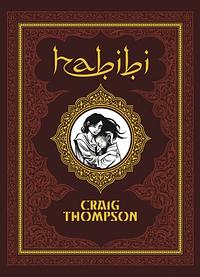Take a photo of a barcode or cover
An interesting story. I did not know that Habibi meant someone whom the speaker loves.
The story takes some twists and turns that I did not expect. I would recommend this for adult readers.
The story takes some twists and turns that I did not expect. I would recommend this for adult readers.
Te engancha desde el principio, te adentras en sus paginas y vives la historia.
La historia es triste, bonita y entrañable y se quedara guardada en mi memoria.
La historia es triste, bonita y entrañable y se quedara guardada en mi memoria.
I certainly didn't understand all the allusions, but the story was clearly both classic and somehow completely out of time. Very sad portrayal of bodies, othering, race, sexuality, prostitution, and the value of the flesh (particularly a woman's flesh in certain settings, times, and places).
It was a very good story, but it was also emotionally exhausting to see so much suffering in one (or possibly more) lives play out.
It was a very good story, but it was also emotionally exhausting to see so much suffering in one (or possibly more) lives play out.
challenging
dark
sad
slow-paced
Plot or Character Driven:
Character
Strong character development:
Complicated
Loveable characters:
N/A
Diverse cast of characters:
Complicated
Flaws of characters a main focus:
No
Minor: Racism, Sexual assault, Sexual violence, Sexual harassment
hopeful
reflective
sad
medium-paced
Plot or Character Driven:
A mix
Strong character development:
Yes
Loveable characters:
Yes
Diverse cast of characters:
Yes
Flaws of characters a main focus:
Yes
One of my closest friends has been telling me for quite a while that I needed to read Habibi. Now that I finally have, I don't think I can say enough good things about it. Habibi is a powerful story of the suffering and survival of Dodola and Zam, two escaped child slaves whose only comfort in the world is the company of each other. The two live in a fictional landscape that is a blend of historical, modern, and fantastical elements, where the wealthy live in splendor but despoil the landscape, forcing the poor to live in filth. Regardless, Dodola and Zam form a love for each other that is equal parts familial and romantic, and so strong that they cling to its memory for survival even years after they are torn apart. The story is heartwarming and heartbreaking, uplifting, life-affirming, and hopelessly bleak. In addition, Habibi is very much a story about the power of stories. Dodola frames her world in relation to stories, both from the Quran and from Arabic folklore, which only serves to enhance the power of her own story and paint it in a light that is almost mythic. Thompson's narrative often compares the ink of stories to the flowing water of a river, and though I don't know enough about Islamic culture to know if this is a cultural device or his own invention, I find it an inspired comparison. The line between story and reality is frequently blurred in Habibi, and ink and water flow into one another, hinting at an intimate connection between storytelling and the precious life-giving water of Habibi's world. I don't believe that Thompson is trying to show the world the importance of storytelling. Rather, I think Habibi celebrates the necessity of storytelling to the human experience by presenting the reader with a world where fiction cannot easily be separated from reality. I could go on and on and not even scratch the surface of the intricate web of interconnected stories and symbols that Thompson has crafted here. This story (and the breathtaking art that surrounds it) is truly a masterpiece.
adventurous
challenging
dark
emotional
funny
hopeful
informative
inspiring
mysterious
reflective
sad
tense
fast-paced
Plot or Character Driven:
A mix
Loveable characters:
Yes
Flaws of characters a main focus:
Yes
Graphic: Adult/minor relationship, Child abuse, Child death, Death, Drug use, Gore, Misogyny, Racial slurs, Rape, Self harm, Sexual assault, Sexual violence, Slavery, Suicidal thoughts, Torture, Transphobia, Violence, Xenophobia, Excrement, Vomit, Murder
Something I'll probably have to read a dozen times to appreciate. Really enjoyed the art, and the way it enhanced the story. I'm new to graphic novels so it was cool to read. The story itself kind of reminded me of the Kite Runner, set in a middle eastern area and just made me feel kind of depressed the entire time.
Lovely, but lacking the honesty of Blankets. Beautiful art and a compelling story.
Craig Thompson spent more than 6 years creating this graphic novel, which was intended to humanize Arabs and Islam with Americans after 9/11, according to Thompson. In the interview he gave in 2011. he said that he was having fun playing with Orientalism in the same way as the cowboys and Indians genre don't represent the true American West, but they're inaccurate interpretations, a fairy tale genre. And that's where all the problems of Thompson's Habibi are coming.
Sure, it has nice art, but the only nice art is Thompson's calligraphy and use of geometry symbols, and Arabic art. However, that is just a copy, an attempt to recreate something created by others. There is also his usage of surahs from Qur'an where he draws parallels with the Bible and shows people that Islam is no different from Christianity and Judaism, and it comes from the same place.
Everything else in this celebrated graphic novel is bad and doesn't serve the purpose of humanizing Arabs and Islam. Quite contrary, it reinforces stereotypes of the Western view of the Arab world and Islam where women are raped and treated only as sexual objects, where all men are rapists and slaves are sold easily.
Apparently, Thompson never visited the Middle East, his only touch with the Arab world was his visit to Morocco, which is a bit sad, and even though he spent six years creating and researching this graphic novel, he didn't bother to visit and meet people (show me hijra community in any Arab country, Thompson). That would have been ok, as many other authors never visited places they were writing about if it wasn't for one small thing. He claims that he was playing with Orientalism, but in reality, he just wrote another novel filled with the same clichés and stereotypes.
His Wanatolia isn't fairytale-like, as he intended it to be, but a mess of a creation. At one point it looks like a country stuck in the Middle Ages, only to be an advanced and modern nation in the next. He mentions many issues such as lack of water, slavery, etc. yet doesn't bother to explore them in this 600+ pages graphic novel.
Romanticizing the rape and oversexualizing the main female character also doesn't benefit him, especially when you draw it in a comical style. As if I'm reading an issue of [b:Iznogud|36218506|Iznogud|René Goscinny|https://i.gr-assets.com/images/S/compressed.photo.goodreads.com/books/1505080224l/36218506._SX50_.jpg|57854462] with the rape and nudity, and nobody can take it seriously.
In the end, the love story of Dodola and Zam is wrong on so many levels. They start as a brother and sister (not a real one), then as a mother and a child. She keeps talking about him as her only child only to tell him that she wants to have only his child. Then there is the portrayal of Dodola as the 9-year-old girl where she's going to her husband with intentions of pleasing him (really, Thomspon? Have you ever seen a child with those thoughts?) and the image of her riding him is distasteful, to say the least.
There are so many other things that downgrade this novel and mar its intentions, which could have been good, but the idea is not well executed. Note to Thompson, just because you wrote something knowingly racist doesn't mean it doesn't read like that. Two stars only for certain panels.
Sure, it has nice art, but the only nice art is Thompson's calligraphy and use of geometry symbols, and Arabic art. However, that is just a copy, an attempt to recreate something created by others. There is also his usage of surahs from Qur'an where he draws parallels with the Bible and shows people that Islam is no different from Christianity and Judaism, and it comes from the same place.
Everything else in this celebrated graphic novel is bad and doesn't serve the purpose of humanizing Arabs and Islam. Quite contrary, it reinforces stereotypes of the Western view of the Arab world and Islam where women are raped and treated only as sexual objects, where all men are rapists and slaves are sold easily.
Apparently, Thompson never visited the Middle East, his only touch with the Arab world was his visit to Morocco, which is a bit sad, and even though he spent six years creating and researching this graphic novel, he didn't bother to visit and meet people (show me hijra community in any Arab country, Thompson). That would have been ok, as many other authors never visited places they were writing about if it wasn't for one small thing. He claims that he was playing with Orientalism, but in reality, he just wrote another novel filled with the same clichés and stereotypes.
His Wanatolia isn't fairytale-like, as he intended it to be, but a mess of a creation. At one point it looks like a country stuck in the Middle Ages, only to be an advanced and modern nation in the next. He mentions many issues such as lack of water, slavery, etc. yet doesn't bother to explore them in this 600+ pages graphic novel.
Romanticizing the rape and oversexualizing the main female character also doesn't benefit him, especially when you draw it in a comical style. As if I'm reading an issue of [b:Iznogud|36218506|Iznogud|René Goscinny|https://i.gr-assets.com/images/S/compressed.photo.goodreads.com/books/1505080224l/36218506._SX50_.jpg|57854462] with the rape and nudity, and nobody can take it seriously.
In the end, the love story of Dodola and Zam is wrong on so many levels. They start as a brother and sister (not a real one), then as a mother and a child. She keeps talking about him as her only child only to tell him that she wants to have only his child. Then there is the portrayal of Dodola as the 9-year-old girl where she's going to her husband with intentions of pleasing him (really, Thomspon? Have you ever seen a child with those thoughts?) and the image of her riding him is distasteful, to say the least.
There are so many other things that downgrade this novel and mar its intentions, which could have been good, but the idea is not well executed. Note to Thompson, just because you wrote something knowingly racist doesn't mean it doesn't read like that. Two stars only for certain panels.




